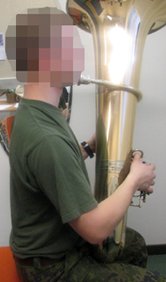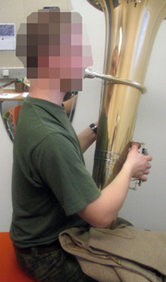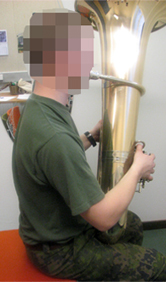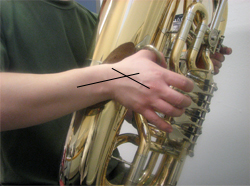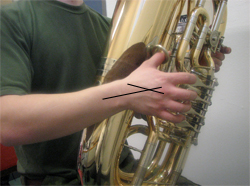Tuba - harjoittelu
Tuuba
The body's centre position is the basic position to which the musician always returns. In the centre position, the spine maintains its natural curves. Spinal curves vary between individuals; in the centre position, the backs and hips of different people may look different.
Read the Ergonomics Overview first.
To find the correct posture, tubists should first examine the position of their pelvis. The pelvis should be in the centre position so that the muscles supporting the pelvis and the spine can work freely (the ischia point directly downwards in a seated position). The tuba is a heavy instrument, and the musician needs strong shoulder blade muscles as well as good control of the midriff muscles.
The thoracic spine should also be in the centre position to ensure a mobile rib cage and correct breathing. When the thoracic spine is in the centre position, the breastbone is in a vertical position and the back extensors are engaged but not tense. When inhaling, the rib cage can expand freely in all directions, including sideways and backwards. The rib cage/thoracic spine and the pelvis should be aligned when viewed from the side. If the thoracic spine tilts backwards in relation to the pelvis, rib cage and diaphragm movement is affected and the musician's breathing suffers.
The centre position of the head and neck can be found by first moving the head back and forward, then leaving it in the centre position where there is free movement between the skull and the cervical spine. The position of the neck, head and jaw joints has an effect on the control of neck muscles, jaw muscles and throat muscles. The head and the neck should be in the centre position to facilitate good support for the head from the deep neck muscles. These support muscles enable the superficial muscles to relax. If the head pushes forward (often as a result of a faulty position in the lower spine), it increases tension in the neck muscles, jaw muscles and superficial neck muscles, which can affect the playing technique.
A correct position of the thoracic spine and the rib cage enables optimal muscular support for the shoulder blades. The shoulder blades should be in a vertical position against the ribs, encouraging a natural position of the shoulders. If the shoulder blade tilts forward and/or wings off of the ribs, the shoulder blade support muscles cannot function correctly, affecting the mobility of the rib cage. The three-dimensional movement of the shoulder blade can be difficult to perceive, and the musician may require professional help during shoulder blade exercises.
When the neck and the head are in the centre position, the musician's lips engage with the mouthpiece of the tuba without having to push the head forward or lower the torso. If the instrument is too low, a cushion of a suitable size should be placed between the instrument and the thigh. If the instrument - and its mouthpiece - are too low, the musician is forced to curve his or her back forward, which causes strain on the lower back and in the neck and shoulder region, and affects the breathing.
|
The pelvis and spine are in the centre position; the mouthpiece is too low. |
Place a support, such as a cushion, under the instrument to raise it to the correct height. |
The pelvis tilts back, the spine curves forward; the instrument/mouthpiece is too low. |
The left arm and the shoulder blade muscles (especially the left-hand side) support the instrument against the body. Insufficient support of the shoulder blade can force the musician to twist his or her body. The tuba requires a lot of right-hand reach. The reach can be improved by good palmar muscles. The wrist should be in the centre position, i.e. extended 15 degrees and tilted 15 degrees towards the little finger. For tubists, a typical faulty position involves bending the wrist and tilting it too far towards the little finger, which overexerts the wrist.
|
|
|
Pushing the head and the neck forward is relatively common among brass musicians. The pelvis and the lumbar spine have some effect on the position. If the pelvis tilts posterior (forward), the head pushes forward. For some musicians, pushing the head forward is a pure habit. Concentrating on bringing the instrument to the lips (rather than taking the lips to the instrument) helps to maintain the neck and the head in the centre position. Mirrors are useful in eliminating incorrect movement.

